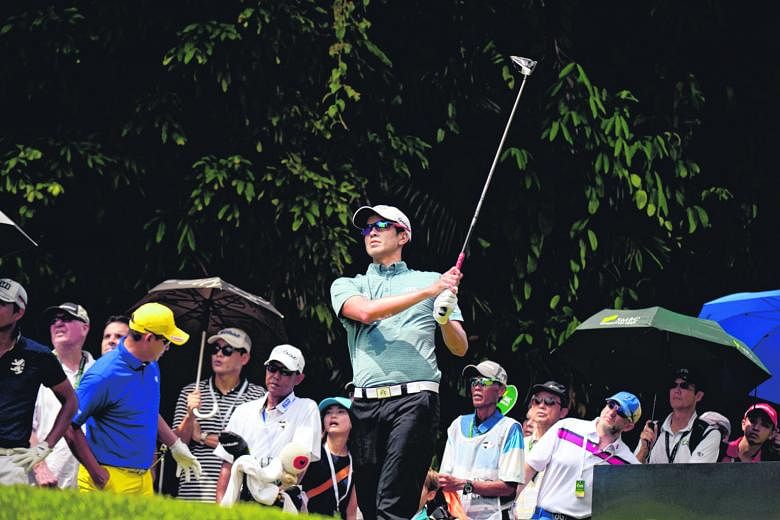All week at the SMBC Singapore Open, many of the world's top golfers praised the Sentosa Golf Club, calling it one of the best they have played at.
Former world No. 1s Adam Scott and Ernie Els observed that the award-winning Serapong Course, which has hosted the US$1 million (S$1.4 million) tournament since 2005, keeps getting better through the years.
Yet the same cannot be said of the game in Singapore. Whereas once it was thriving on several fronts, golf's lustre has faded.
The closure of clubs and retail stores has hit the community hard, as it struggles to produce professional golfers capable of winning regularly on regional circuits such as the Asian Tour.
Even the Singapore Open is struggling to recapture its heyday from earlier this decade, when it boasted a US$6 million prize purse in 2011 and 2012 to be Asia's richest national Open.
-
FIGURING OUT GOLF'S DECLINE IN SINGAPORE IN %
-
GOLF CLUBS (22 IN 2001 TO 17 IN 2017)
-23 -
NUMBER OF RETAIL STORES
-40 -
LOCAL COACHES' FEES
-30
-
YOUTH GOLF PROGRAMME
-56
Current annual enrolment is 200, down from its peak of 450 six years ago. -
SINGAPORE OPEN ATTENDANCE
-50
Estimated attendance of 20,000 at last year's SMBC Singapore Open. The Open's record was 40,000 in 2008. -
TOURNAMENTS
-85
Drop in number of tournaments as you move from Malaysia (26 last year) to Singapore (four).
With fan support dwindling as the biggest golf stars give the Republic a miss in their annual Tour schedules, the future of Singapore golf looks uncertain even as it tries to downsize in scale to fit the needs of a smaller but no less dedicated community.
CLOSURES ABOUND
The news this month that the Government would acquire Raffles Country Club for the Singapore-Kuala Lumpur high-speed rail project came about 18 months after a similar announcement regarding Jurong Country Club.
With the closures of Keppel Club and Marina Bay Golf Club when their leases expire in the next decade, there will only be 13 golf clubs here by 2025; down from the current 17 and 22 in 2001.
This drop in numbers is mirrored by the struggles of golf vendors.
Local retailers like Pan West and Golf House have closed several of their standalone stores in recent years.
An industry insider estimated that the number of stores that carry golf apparel and equipment here has dropped by as much as 40 per cent.
Internationally, the downturn is similar. Nike and adidas last year stopped their involvement in the golf equipment business due to flagging sales, not helped by the flailing global economy.
The fortunes of local teaching professionals have also suffered.
Fewer clubs mean fewer driving ranges where they can give lessons. This, coupled with the closures of public ranges in Sin Ming and Taman Jurong, has affected his members, noted Singapore Professional Golfers Association (SPGA) president M. Murugiah.
He said: "For many of my boys, coaching is their bread and butter, and they're earning 20 to 30 per cent less these days."
PROFESSIONAL WOES
Times are tough too for those who compete for a living. For many years, Mardan Mamat, 49, and Lam Chih Bing, 41, have been Singapore's flagbearers on the Asian Tour but both veterans, with six titles between them, are in the twilight of their careers.
Their successors - Quincy Quek, Choo Tze Huang and Koh Deng Shan, all of whom are under 30 - have yet to win on the Asian Tour and Mardan says they will continue to struggle as they do not get the same amount of exposure as their counterparts in Thailand, Malaysia and the Philippines.
Thailand's domestic circuit had 22 events over the past two years while Malaysia had 26 tournaments in 2016. With limited resources, the SPGA organised seven events in 2015 and four last year.
Both Mardan and Murugiah appealed to local companies for greater financial support.
Mardan said: "We don't have a strong domestic tour to build up our youngsters, unlike these countries. You need that experience to reach the next level."
GRASSROOTS HURDLES
Overall participation numbers in Singapore, much like the global trend in the United States and Europe, are also not encouraging.
There are several factors for this. Tiger Woods' decline has robbed the game of its sole iconic global superstar and lowered its profile; the rise of sports like cycling and mixed martial arts that cater to millennials unwilling to spend five hours on the fairways; finally, the lack of public courses here and expensive green fees at private clubs.
The Singapore Golf Association (SGA) estimates that, of the 27,000 active golfers registered here, about 10 per cent are aged 35 and below.
Its president Ross Tan, who took over the helm last year, said: "In the past, we perhaps placed too much emphasis on elite golf and trying to win medals, and not enough was done at the grassroots level to widen the base."
The Ministry of Education officially recognised golf as a co-curricular activity (CCA) in 2002 and within a few years, more than 70 primary and secondary schools offered it.
But the landscape has changed as golf's appeal dimmed. The Singapore Sports School, for example, no longer lists golf as one of its core academy programmes.
Janice Khoo, chairman of the Youth Golf Programme (YGP) which introduces golf to youngsters without the means to become members of a golf club, said: "Many schools also no longer offer golf as a CCA. It is a worrying trend."
The YGP, whose patron is Minister of State for Manpower Teo Ser Luck, has benefited close to 5,000 students since its inception in 1997.
At its peak around five to six years ago, said Khoo, enrolment was about 450 kids annually but that has dropped to about 200.
She added: "There is still interest, so we need to find a more targeted approach and work with the schools."
SMALLER MARQUEE EVENT
The Singapore Open, previously backed by Barclays, drew big names like Phil Mickelson and Rory McIlroy and big crowds. The 2008 edition drew a record 40,000 fans.
But from 2013-2015, it was forced into a hiatus because it could not find a sponsor. It returned only last year following SMBC's backing.
Patrick Feizal Joyce, the vice-president of golf for tournament promoter Lagardere Sports, conceded that the days of such enormous purses are gone and the boom "has significantly tapered off".
But he stressed that things are not as dire as imagined. Last year's Singapore Open had then-world No. 1 Jordan Spieth as its headline act and drew close to 20,000 spectators during the tournament week.
Besides the return of fan favourites Scott and Els, this week also saw the debut of Spanish star Sergio Garcia.
Fixing the malaise of Singapore golf, however, is a tougher task, Joyce said.
"Courses here are not accessible to the average person... If you want to grow the game, you need to let more people play, not keep it exclusive to a small group."
STOPPING THE DECLINE
SGA's Tan is keen to stem the slide. Besides encouraging local clubs to explore ways to make the game more accessible and shorter - six-hole courses that take less than 11/2 hours to play is one possibility - the SGA has started a sub-committee for junior development and will add a junior squad to its development and national teams.
Tan also wants to tap into the R&A, which opened its new Asia-Pacific office at SGC last November and whose goal is to develop golf worldwide.
He said: "It's not too late but we need to act now."


